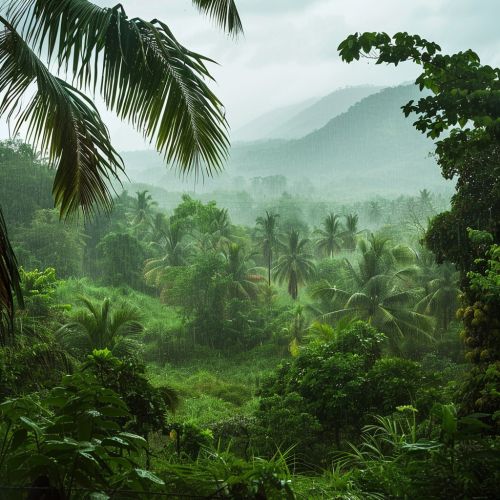Tropical monsoon climate
Introduction
The Tropical monsoon climate, also known as tropical wet or simply monsoon, is a type of tropical climate that experiences significant rainfall during certain periods of the year. This climate type is typically found in regions close to the equator, particularly in parts of South and Southeast Asia, Africa, the Americas, and the Pacific Islands. The tropical monsoon climate is characterized by high temperatures throughout the year, with a pronounced wet season and a relatively drier season.
Characteristics
Tropical monsoon climates are distinguished by their unique seasonal patterns. Unlike other tropical climates, which experience rainfall throughout the year, monsoon climates have a distinct wet season and dry season. The wet season is characterized by heavy rainfall due to the presence of the monsoon, a seasonal reversing wind system. The dry season, on the other hand, sees significantly less rainfall.


The temperature in tropical monsoon climates remains high throughout the year, typically above 18 degrees Celsius, even during the dry season. This is due to the regions' proximity to the equator, which receives a high amount of sunlight throughout the year. The high temperatures, combined with the heavy rainfall during the wet season, create a humid environment ideal for the growth of lush vegetation and diverse wildlife.
Distribution
Tropical monsoon climates are found in various parts of the world, particularly in regions close to the equator. These include parts of South and Southeast Asia, such as India, Bangladesh, Myanmar, Thailand, and the Philippines. In these regions, the monsoon climate is influenced by the Asian monsoon system, which brings heavy rainfall during the summer months.
In Africa, tropical monsoon climates are found in parts of West Africa, Central Africa, and East Africa. The Americas also have regions with a tropical monsoon climate, particularly in parts of Central and South America, including regions in Brazil, Colombia, and Central America. The Pacific Islands, such as Fiji and Samoa, also experience a tropical monsoon climate.
Impact on Ecosystem
The tropical monsoon climate plays a significant role in shaping the ecosystem of the regions it is found in. The heavy rainfall during the wet season provides an abundance of water, leading to the growth of dense forests and a diverse range of plant and animal species. The dry season, while less conducive to plant growth, is still warm enough to support a variety of life forms.
The tropical monsoon climate is particularly conducive to the growth of tropical rainforests, which are among the most biodiverse ecosystems on the planet. These rainforests are home to a vast number of plant and animal species, many of which are not found anywhere else in the world.
Human Impact and Adaptation
Humans have inhabited regions with tropical monsoon climates for thousands of years, and have adapted their lifestyles to the unique challenges and opportunities presented by this climate type. Agriculture, in particular, has been heavily influenced by the monsoon climate. The heavy rainfall during the wet season provides ample water for crops, while the dry season allows for the harvesting and drying of crops.
However, the tropical monsoon climate also presents challenges for human habitation. The heavy rainfall during the wet season can lead to flooding, which can cause damage to homes and infrastructure, and can also lead to the spread of waterborne diseases. Additionally, the high temperatures and humidity can be uncomfortable and can contribute to the spread of certain diseases.
Despite these challenges, humans have developed various strategies to adapt to the tropical monsoon climate. These include the construction of homes and infrastructure designed to withstand heavy rainfall and flooding, the development of agricultural practices suited to the wet and dry seasons, and the implementation of public health measures to combat the spread of diseases.
